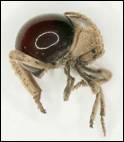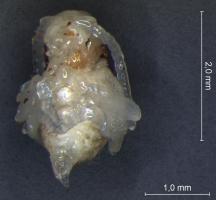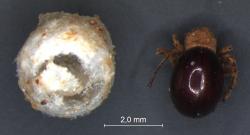
Mezium affine (Boieldieu, 1856)
Synonym(s) :
Common names
-
 Ptine luisant
Ptine luisant -
 Hood Spider beetle shiny Spider beetle shining Ptinus
Hood Spider beetle shiny Spider beetle shining Ptinus -
 Escarabo araña
Escarabo araña -
 Kugelkäfer
Kugelkäfer
Classification:
- Order:
- Family:
- Genus:
- Species:
Frequency index:
Overview
Ptinidae were once a family of their own, but they have now been included into the Anobiidae family (cf. fact-sheets).
Shiny spider beetles have a characteristic aspect and can be mistaken for small spiders, hence their name.
They are polyphagous insects that feed on dry organic debris of animal or plant origin.
They are common inconspicuous guests in museums, warehouses, housings, libraries, cellars, attics… where they can cause some damage to various materials and products.
Recognition criteria

Adult
Size
2.5 to 3.5 mm long
Aspect
Look like small spiders, but have only 3 pairs of legs (spiders have 4).
Sturdy, rounded, pearl-shaped body. Upper part of abdomen completely smooth. Fairly long, 11-articled antennae.
Colour
Shiny, fully orange-brown elytra. Head, thorax and legs entirely covered in a dense, scaly, golden or greyish pubescence.

Larva
Size
4.5 mm long at the last developmental stages.
Aspect
Look like small, slightly arched white grubs, with a more or less erect hairiness
Colour
Yellowish white body, brownish yellow head. Yellowish hairiness.
Development cycle
The biology of that species is close to that of other Anobiidae species.
Their development cycle requires 12 to 16 weeks on an average, but only 7 in optimal conditions at 33°C.
They are a univoltine species (there is only one generation per year) whose growth rate is low despite a rather short time span needed to reach full development.
Females’ fecundity varies between 50 and 100 eggs. They are laid in early summer and hatch 2 weeks later. Larval development requires 6 weeks on an average. Nymphosis takes place in a kind of tight cocoon, and after 3 or 4 weeks adults get out and reach the outside world.
Infected materials
Mezium affine have a polyphagous food diet composed of grains, all kinds of seeds, dried fruit, dried meat, wool, hair, hairs, feathers, skins, book-bindings, insect remains, dried mushrooms, animal excrements, sugar, and many more foodstuffs. They are fond of dark, quiet places (cellars, barns, attics) and are preferentially found in old food stores, libraries, museums, where they can infest animal collections, amongst others.
Geographical distribution
They are widely distributed worldwide, except in Asia.






